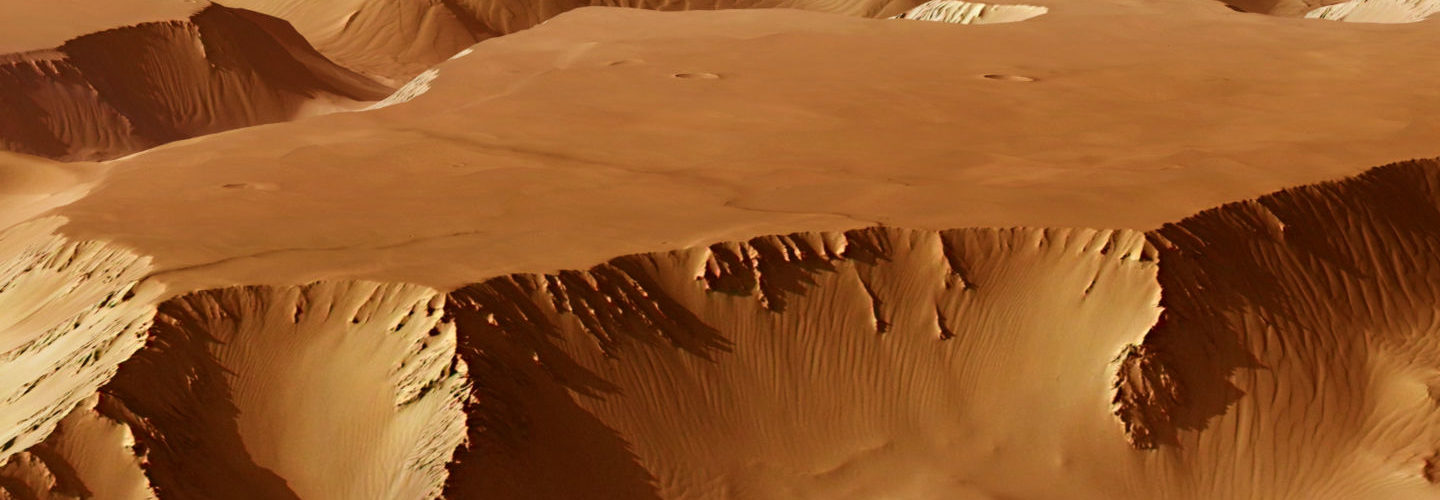


Is there anything more exciting than exploring space? A few million miles from Earth, our celestial neighbor, Mars, floats in space. It hides eons of geological history just beneath its red-hued surface. One of the best ways for us to study the Red Planet is through deep-space probes, like the European Space Agency’s Mars Express.
The ESA launched the Mars Express in 2003. At first, it seemed to be a disappointment, as it never established connection with Earth. However, scientists discovered that the probe was still intact, it just wasn’t sending a signal because its antennae didn’t deploy. Thankfully, connection with the probe has been reestablished, and it has sent back some absolutely stunning photos.
Photo Credit: ESA/DLR/FU Berlin
Hebes Chasma

Photo Credit: ESA/DLR/FU Berlin
This image shows a mesa within the Hebes Chasma. The horseshoe-shaped indention has some black substance piled at the bottom. This image captures some of the rugged beauty of the Martian geography.
Noctis Labyrinthus

Photo Credit: ESA/DLR/FU Berlin
This stunning picture shows motion and makes Mars feel like a living place. The tumbling sand, the windswept landscape and the dramatic lighting all make you feel like you could walk out onto this plateua.
Arabia Terra

Photo Credit: ESA/DLR/FU Berlin
The Arabia Terra region is dotted with various impact craters. The craters are all showing varying degrees of erosion, as each was made in very different eras of Mars’ history.
The South Pole

Photo Credit: ESA/DLR/FU Berlin
Here you can see the southern pole of Mars. That large white region is frozen ice and carbon dioxide. While it looks smooth from this distance, that region is actually full of chasms and plateaus. Shots like this serve as a reminder that mars had water on its surface once. Can you imagine what a Mars with rivers and lakes would have been like?
Unnamed Crater

Photo Credit: ESA/DLR/FU Berlin
In this image of an unnamed crater, you can see a massive body of frozen water ice in the bottom. The crater pictured is hundreds of miles wide. Imagining the impact that would have caused such a reshaping of the surface is mind-boggling!
Seasons on Mars

Photo Credit: ESA/DLR/FU Berlin
Here you can see a portion of the northern ice caps of Mars in summer. In the summer, the carbon dioxide ice actually evaporates into the atmosphere. Only the water ice is left behind. That should give you some indication of just how cold the Red Planet is! For context, carbon dioxide freezes at -109.3 degrees Fahrenheit, which is -78.5 degrees C. When winter returns, the ice caps will once again be covered in carbon dioxide ice.
The North Pole

Photo Credit: ESA/DLR/FU Berlin
These breathtaking spiral patterns are formed by Mars’ north pole. This shot, as you can see, was taken from an angle, so as to capture the starry sky beyond the cold planet.
Phobos

Photo Credit: ESA/DLR/FU Berlin
Pictured here is Phobos, one of Mars’ moons. The surface is craggy and riddled with craters from countless meteor impacts in the distant past. Phobos has such a small mass that a human on it would feel like Superman. The gravity is so low, you could easily leap twenty feet into the air.
Reull Vallis

Photo Credit: ESA/DLR/FU Berlin
This is Reull Vallis, a region well-known for its channels that resemble dry riverbeds. New research suggests that’s exactly what they are: geographical features caused by running water cutting across the landscape. Scientists have noticed similarities between this region of Mars and the glacial valleys of our own Earth. It is incredible to think that, at one point in time, Mars may have looked like our very own planet does now.
The Most Amazing Picture from the Mars Express

Photo Credit: ESA/DLR/FU Berlin
In this stunning shot, you can see the southern ice cap of Mars. This shot gives a great perspective for the ice cap’s size relative to the planet. Remember, Mars is only a little smaller than Earth: you could easily fit all of North and South America in the landmass you see pictured.











No comments so far.
Be first to leave comment below.